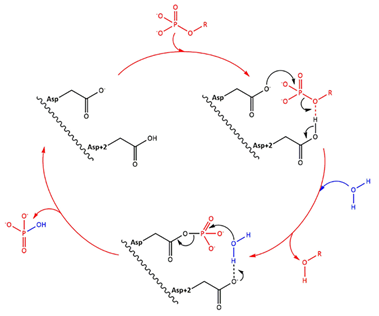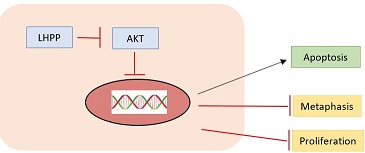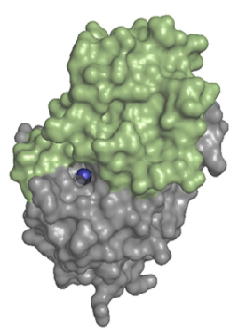Sandbox Reserved 1480
From Proteopedia
| (27 intermediate revisions not shown.) | |||
| Line 4: | Line 4: | ||
== Function == | == Function == | ||
| - | The <scene name='80/802654/2x4d/1'>human protein LHPP</scene> or phospholysine phosphohistidine inorganic pyrophosphate phosphatase (hLHPP) is a phosphatase with an in vitro activity towards inorganic pyrophosphate, imidodiphosphate, 3‑phosphohistidine and 6‑phospholysine. hLHPP is part of the haloacid dehalogenase family (HAD) . It is a protein of 271 amino acids which is encoded by a seven exon gene positioned on the chromosome 10. The enzyme acts more effectively on N-P bonds than O-P bonds, and is found on the nucleus and in the cytoplasm. | + | <div align='justified'>The <scene name='80/802654/2x4d/1'>human protein LHPP</scene> or phospholysine phosphohistidine inorganic pyrophosphate phosphatase (hLHPP) is a phosphatase with an in vitro activity towards inorganic pyrophosphate, imidodiphosphate, 3‑phosphohistidine and 6‑phospholysine. hLHPP is part of the haloacid dehalogenase family (HAD) . It is a protein of 271 amino acids which is encoded by a seven exon gene positioned on the chromosome 10. The enzyme acts more effectively on N-P bonds than O-P bonds, and is found on the nucleus and in the cytoplasm.</div> |
| - | + | ||
[[Image:HAD.PNG]] | [[Image:HAD.PNG]] | ||
| Line 21: | Line 20: | ||
It has also been shown that LHPP is a histidine phosphatase and a tumour suppressor in hepatocellular carcinoma that removes histidine-linked phosphate groups from proteins. The absence of LHPP promotes the growth of tumors via increasing histidine-phosphorylated proteins. This study shown that LHPP was downregulated in hepatocellular carcinoma, but also that two histidine kinases (NME1 and NME2) were upregulated. Thus, the regulation of protein phosphorylation is important for the integrity of the cell and when deregulated could lead to tumorigenesis. Collectively, this study provides unprecedented hints on cellular functions of LHPP, and shows that LHPP inactivation together with high NME1/2 expression and - activity is a key tumorigenic event in hepatocellular carcinomas. | It has also been shown that LHPP is a histidine phosphatase and a tumour suppressor in hepatocellular carcinoma that removes histidine-linked phosphate groups from proteins. The absence of LHPP promotes the growth of tumors via increasing histidine-phosphorylated proteins. This study shown that LHPP was downregulated in hepatocellular carcinoma, but also that two histidine kinases (NME1 and NME2) were upregulated. Thus, the regulation of protein phosphorylation is important for the integrity of the cell and when deregulated could lead to tumorigenesis. Collectively, this study provides unprecedented hints on cellular functions of LHPP, and shows that LHPP inactivation together with high NME1/2 expression and - activity is a key tumorigenic event in hepatocellular carcinomas. | ||
| - | LHPP | + | LHPP regulates AKT to control the growth of liver cancer because AKT can block apoptosis and thereby promote cell survival and is considered as an essential factor in the development of many types of cancer. |
Moreover, LHPP apparently inhibited the metastasis of cervical cancer cells, as evidenced by the reduced expressions of MMP-2, MMP-9, TGF-β1, Fibronectin, N-cadherin and Vimentin, and the enhanced E-cadherin. | Moreover, LHPP apparently inhibited the metastasis of cervical cancer cells, as evidenced by the reduced expressions of MMP-2, MMP-9, TGF-β1, Fibronectin, N-cadherin and Vimentin, and the enhanced E-cadherin. | ||
| Line 36: | Line 35: | ||
== Structural highlights == | == Structural highlights == | ||
| - | + | [[Image:Capture.jpg]] | |
| + | ''Fig 3. Simplified structure of LHPP. 1: Pyrophosphate, 2: Magnesium ion, 3: 4-(2-hydroxyethyl)-1-Piperazine ethanesulfonic acid, 4: Glycerol. A, B: the two protein subunits of the homodimer. Source : Uniprot, 2018'' | ||
| - | [[Image:Capture.jpg]] | ||
| - | '' | + | LHPP forms a homodimer in solution. Each <scene name='80/802654/2x4d_monomer/10'>monomer</scene> of hLHPP has two domains, one catalytic domain with a <scene name='80/802654/Mg_ion/4'>phosphoric acid and a magnesium ion</scene> (Mg2+) on the <scene name='80/802654/Catalityc_site/5'>active site</scene> and a large C2a-type cap domain which control the accessibility to the active site (see Fig 4). Despite the large cap, the enzyme is not only able to act on small metabolites, but also on phosphoproteins. |
| - | + | ||
| + | The <scene name='80/802654/Catalityc_site_aa/7'>amino acids</scene> involved in the catalytic center are number 18 to 22, from 55 to 60, 155, 190, from 214 to 216, 219 and 220 corresponding respectively to DISGV, TNESAA, G, K, GDD, G and D. | ||
| - | + | [[Image:2 domains.png]] | |
| + | |||
| + | ''Fig 4. Structure of a monomer of hLHPP. The catalytic domains is shown in gray, and the C2a-type cap domains is colored in green. The essential Mg2+ cofactor in the active site is shown as a blue sphere. Source : Do metabolic HAD phosphatases moonlight as protein phosphatases? Antje Gohla. (2018) [BBA - Molecular Cell Research]'' | ||
| + | |||
| + | |||
| + | Full crystallographic information is available from [https://oca.weizmann.ac.il/oca-docs/fgij/fg.htm?mol=2x4d OCA] | ||
</StructureSection> | </StructureSection> | ||
| Line 58: | Line 62: | ||
"Down-regulation of LHPP in cervical cancer influences cell proliferation, metastasis and apoptosis by modulating AKT", (2018), [PubMed] [Main] | "Down-regulation of LHPP in cervical cancer influences cell proliferation, metastasis and apoptosis by modulating AKT", (2018), [PubMed] [Main] | ||
| + | |||
| + | "The human LHPP page on Uniprot.org [https://www.uniprot.org/uniprot/Q9H008]" | ||
Current revision
| This Sandbox is Reserved from 06/12/2018, through 30/06/2019 for use in the course "Structural Biology" taught by Bruno Kieffer at the University of Strasbourg, ESBS. This reservation includes Sandbox Reserved 1480 through Sandbox Reserved 1543. |
To get started:
More help: Help:Editing |
Structure of the protein LHPP
| |||||||||||
References
"Molecular cloning of a cDNA for the human phospholysine phosphohistidine inorganic pyrophosphate phosphatase." Yokoi F., Hiraishi H., Izuhara K. J. Biochem. 133:607-614(2003) [PubMed] [Europe PMC] [Abstract]
"The protein histidine phosphatase LHPP is a tumour suppressor." Sravanth K. Hindupur, Marco Colombi, Stephen R. Fuhs, Matthias S. Matter, Yakir Guri, Kevin Adam, Marion Cornu, Salvatore Piscuoglio, Charlotte K. Y. Ng, Charles Betz, Dritan Liko, Luca Quagliata, Suzette Moes, Paul Jenoe, Luigi M. Terracciano, Markus H. Heim, Tony Hunter & Michael N. Hall. (2018) [PubMed] [Main]
"Do metabolic HAD phosphatases moonlight as protein phosphatases?." Antje Gohla. (2018) [BBA - Molecular Cell Research]
"Down-regulation of LHPP in cervical cancer influences cell proliferation, metastasis and apoptosis by modulating AKT", (2018), [PubMed] [Main]
"The human LHPP page on Uniprot.org [1]"




